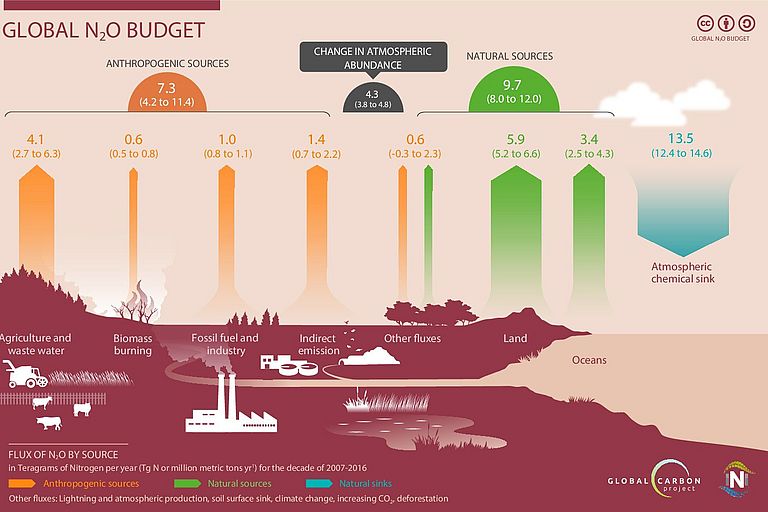Increasing usage of nitrogen fertilizer poses an increasing climate threat
Study in Nature shows sources for rising nitrous oxide concentration in the atmosphere
Not only has the amount of carbon dioxide in the atmosphere increased significantly since the beginning of industrialization. The concentrations of other greenhouse gases such as nitrous oxide have also increased measurably. Nitrous oxide is a highly effective and durable climate gas currently contributing about seven percent to global warming. However, there are uncertainties as to where the additional nitrous oxide comes from and where sinks exist.
An international consortium of 57 scientists from 14 countries and 48 research institutions, including the GEOMAR Helmholtz Centre for Ocean Research Kiel, has carried out the most comprehensive assessment to date of all sources and sinks of nitrous oxide as part of the Global Carbon Project and the International Nitrogen Initiative. The results of the project led by the Auburn University (Alabama, USA) were published now in the international scientific journal Nature. They not only show that the concentration of nitrous oxide in the atmosphere has increased by 20 percent compared with pre-industrial levels. They also show that the increase has accelerated in recent decades due to emissions from various human activities.
So far, nitrous oxide emissions from the ocean have been a major source of uncertainty. “For this new study, we have used a novel global Earth system model”, explains Angela Landolfi of GEOMAR, co-author of the study. “And we now have a better understanding of the biogeochemical feedback that influences nitrous oxide production and emissions in the ocean. This has enabled us to better model oceanic nitrous oxide emissions and significantly reduce the existing uncertainties compared to previous estimates, for example in the Fifth Assessment Report of the Intergovernmental Panel on Climate Change in 2014”.
Extensive data collection in the tropical ocean, for example within the framework of Collaborative Research Center 754, and the global nitrous oxide data collection MEMENTO have also contributed to this. They have been incorporated into the calibration of the Earth system models and have enabled a better understanding of marine nitrous oxide formation and degradation processes.
However, the main reason for the increase of nitrous oxide in the atmosphere is not found in the ocean but on due to human activities on land. “The dominant driver of the increase in atmospheric nitrous oxide comes from agriculture, and the growing demand for food and feed for animals will further increase global nitrous oxide emissions,” explains the study's lead author, Hanqin Tian, Director of the International Center for Climate and Global Change Research at the School of Forestry and Wildlife Sciences at Auburn University and Andrew Carnegie Fellow.
The international team found that the largest contributions to global nitrous oxide emissions come from East Asia, South Asia, Africa and South America. Emissions from synthetic fertilizer use dominate releases in China, India and the United States, while emissions from livestock manure application are responsible for releases in Africa and South America, the study found. This study is further evidence that increasing emissions of non-CO2 greenhouse gases will make it significantly more difficult to achieve the goals of the Paris Climate Change Convention.
According to the study's co-author, Wilfried Winiwarter from the International Institute for Applied Systems Analysis (IIASA) in Austria and former director of the European center of the International Nitrogen Initiative, there are, however, ways to reduce these emissions. “Europe is the only region in the world that has successfully reduced nitrous oxide emissions over the past two decades,” Winiwarter said. “Industrial and agricultural policies to reduce greenhouse gases and air pollution and to optimize fertilizer use efficiencies have proven to be effective. Still, further efforts will be required, in Europe as well as globally.”
Reference:
Tian, H., Xu, R., Canadell, J.G. et al. A comprehensive quantification of global nitrous oxide sources and sinks. Nature 586, 248–256 (2020). https://doi.org/10.1038/s41586-020-2780-0



